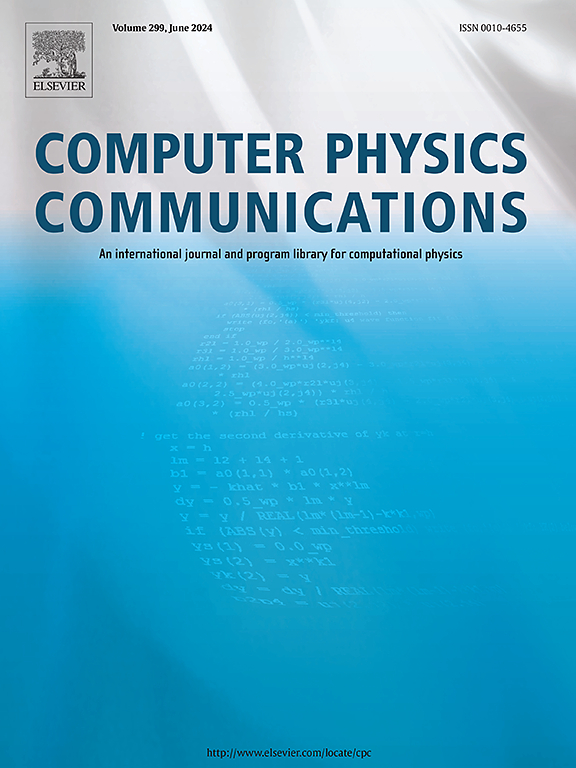Accelerating Gaussian beam tracing method with dynamic parallelism on graphics processing units
IF 7.2
2区 物理与天体物理
Q1 COMPUTER SCIENCE, INTERDISCIPLINARY APPLICATIONS
引用次数: 0
Abstract
This study presents an efficient implementation of the Gaussian beam tracing (GBT) method utilizing graphics processing units (GPUs) to overcome the performance limitations of traditional CPU-based acoustic simulations. The algorithm was implemented and optimized on an NVIDIA RTX A6000 GPU, significantly enhancing the Gaussian beam summation (GBS) performance. We addressed the challenge of irregular control flows inherent to GBT by leveraging CUDA's dynamic parallelism to effectively flatten and dispatch nested loops directly on the GPU. Additionally, a profiling-driven optimization workflow using NVIDIA Nsight Compute enabled targeted improvements, raising SM throughput from 22.27% to 33.32%, L1 cache throughput from 13.15% to 22.15%, and L2 cache throughput from 9.16% to 21.26%. Consequently, the GPU-accelerated GBS algorithm achieved up to an 817× speedup compared to the original single-threaded CPU implementation, while the full computational pipeline reached 112× acceleration in a city-environment scenario involving 16,384 rays. Furthermore, this study introduces innovative strategies for overcoming GPU memory limitations, enabling efficient processing of large-scale ray datasets beyond single-kernel constraints. Finally, we establish systematic performance evaluation methodologies critical for analyzing and tuning GPU-accelerated algorithms, laying a foundation for future enhancements and scalability improvements.
图形处理单元上具有动态并行性的加速高斯光束跟踪方法
本研究提出了一种利用图形处理单元(gpu)有效实现高斯波束追踪(GBT)方法,以克服传统基于cpu的声学模拟的性能限制。该算法在NVIDIA RTX A6000 GPU上进行了实现和优化,显著提高了高斯波束求和(GBS)的性能。我们解决了GBT固有的不规则控制流的挑战,利用CUDA的动态并行性,直接在GPU上有效地平坦和调度嵌套循环。此外,使用NVIDIA Nsight Compute的分析驱动优化工作流程实现了针对性的改进,将SM吞吐量从22.27%提高到33.32%,将L1缓存吞吐量从13.15%提高到22.15%,将L2缓存吞吐量从9.16%提高到21.26%。因此,与原始的单线程CPU实现相比,gpu加速的GBS算法实现了高达817倍的加速,而在涉及16,384条光线的城市环境场景中,完整的计算管道达到了112倍的加速。此外,本研究引入了克服GPU内存限制的创新策略,使大规模射线数据集的有效处理超越了单内核约束。最后,我们建立了对分析和调优gpu加速算法至关重要的系统性能评估方法,为未来的增强和可扩展性改进奠定了基础。
本文章由计算机程序翻译,如有差异,请以英文原文为准。
求助全文
约1分钟内获得全文
求助全文
来源期刊

Computer Physics Communications
物理-计算机:跨学科应用
CiteScore
12.10
自引率
3.20%
发文量
287
审稿时长
5.3 months
期刊介绍:
The focus of CPC is on contemporary computational methods and techniques and their implementation, the effectiveness of which will normally be evidenced by the author(s) within the context of a substantive problem in physics. Within this setting CPC publishes two types of paper.
Computer Programs in Physics (CPiP)
These papers describe significant computer programs to be archived in the CPC Program Library which is held in the Mendeley Data repository. The submitted software must be covered by an approved open source licence. Papers and associated computer programs that address a problem of contemporary interest in physics that cannot be solved by current software are particularly encouraged.
Computational Physics Papers (CP)
These are research papers in, but are not limited to, the following themes across computational physics and related disciplines.
mathematical and numerical methods and algorithms;
computational models including those associated with the design, control and analysis of experiments; and
algebraic computation.
Each will normally include software implementation and performance details. The software implementation should, ideally, be available via GitHub, Zenodo or an institutional repository.In addition, research papers on the impact of advanced computer architecture and special purpose computers on computing in the physical sciences and software topics related to, and of importance in, the physical sciences may be considered.
 求助内容:
求助内容: 应助结果提醒方式:
应助结果提醒方式:


